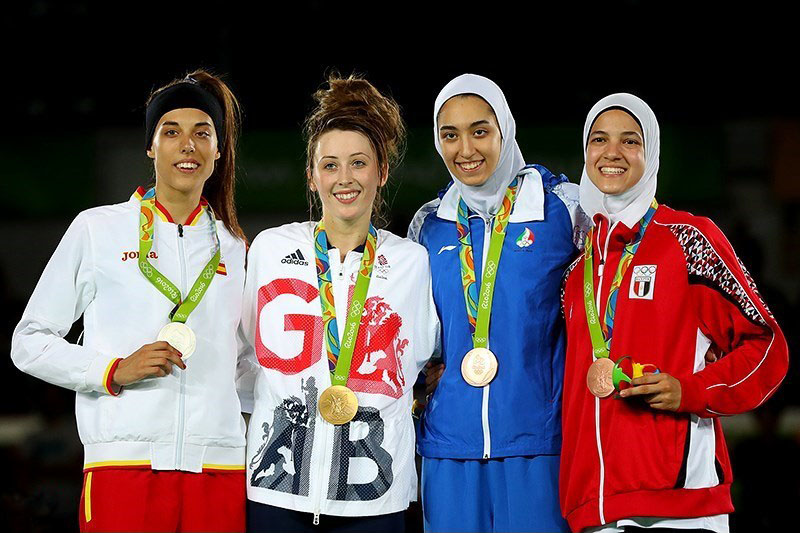Gender and Athletics
Women and Sport in the Muslim World

Austin Bodetti
From proponents of social conservatism to supporters of Islamic feminism, plenty of activists, politicians, and scholars have dwelled on the place of women within the Muslim world. Few, though, have spent time thinking about the region’s fast-expanding number of female athletes. Across the Middle East and beyond, women are moving to take a far more active role in popular sports.
In fighting for equality on the soccer field, women throughout the Middle East have typically found themselves waging an uphill battle against social norms. While these cultural restrictions often slow the region’s female athletes, even long-held taboos rarely stop them.
Clerics at a refugee camp for Palestinians and Syrians in Lebanon, Nahr el-Bared, tried to keep girls from playing soccer because the young players would have to wear shorts to participate. Supported by the charity, “Right to Play,” the female coaches training the girls resolved the dispute with an innovative solution: they built a wall around the field where the girls practiced, to keep the clerics from seeing any games. The project later evolved into an opportunity for the camps’ boys and girls to learn soccer together, a unique opportunity to teach gender equality.
As the episode in Lebanon shows, resistance to women’s participation in sports affects even the most progressive countries in the Middle East. Despite this trend, the region’s most conservative states have tended to consider their female athletes sources of pride.
Kimia Alizadeh chose to compete in the 2016 Summer Olympics in Rio de Janeiro under the flag of Iran, a country notorious for expansive restrictions on women’s rights. She earned the praises of Iranian President, Hassan Rouhani and the country’s hardliners after landing a bronze medal in taekwondo, becoming Iran’s first female Olympic medalist and a cultural icon.
Saudi Arabia, whose record on women’s rights many consider even worse than Iran’s, provides another example. The kingdom fielded its own team of female athletes at the Olympics in 2016. The Saudi women’s landmark participation heralded the kingdom’s wider attempts to reform its image, which have included lifting its much-derided ban on women driving cars.
Though the spread of the coronavirus delayed the 2020 Summer Olympics, Saudi Arabia is planning to send some of those same female stars to Tokyo in 2021 for the rescheduled games, a signal that it wants women to take a wider role in sports and on the international stage. The kingdom also elected a woman to the Saudi Arabian Olympic Committee, giving women a greater voice behind the scenes.
In the Western world, the top Muslim women in sports have made an even bigger splash and are becoming household names. Ibtihaj Muhammad, a fencer from New Jersey, captured headlines in 2016 as the first Muslim-American woman to compete in the Olympics while wearing a hijab. For her part, the teenage Minnesotan, Amaiya Zafar, reversed the International Boxing Association’s ban on the hijab in the hope of qualifying for the 2024 Summer Olympics. In addition to winning their individual battles, the athletes have also overcome stereotypes about Muslim women.
As Muslim women have reshaped sports and popular culture, the titans of the sport industry are starting to stand behind them. Nike unveiled an athletic hijab in 2018 after having developed the much-vaunted product in collaboration with a pair of Muslim athletic stars: Amna al-Haddad, an Emirati weightlifter, and Manal A. Rostom, an Egyptian runner. Nike’s move marked a historic cultural change that the rest of the sport industry seems likely to echo.
Despite Muslim women’s advances in sports in the Middle East and the West alike, this progress has only gone so far in undoing the racism and sexism that has all too often trailed them. Alizadeh, the Olympian from Iran, fled to Europe and plans to compete in the Olympics under a different flag after a leaked video showed her mingling with men. Muhammad, the American Olympian, has faced death threats from fans of fencing hostile to the ascent of a Muslim woman.
These conflicting currents often result in paradoxes. Zeinab Sahafi, a well-known Iranian fan of soccer, had to escape to Turkey to avoid the authorities. She had come under pressure from Iran’s police for evading the country’s ban on women watching soccer at stadiums; she achieved this impressive feat by dressing herself as a man. In an ironic twist, Iran lifted the ban late last year, sparking celebrations from Iranian women but leaving Sahafi to watch games from exile.
Female athletes and fans of sports in the Muslim world may continue to face obstacles for some time to come, but these difficulties should do little to diminish their accomplishments. They have demonstrated that nothing can stop women from dominating sports and pop culture. When Japan hosts the Summer Olympics in 2021, the Middle East’s female athletes will be going for the gold.
AUSTIN BODETTI is a Rabat-based researcher specializing in Middle Eastern studies. His work has appeared in USA Today and Wired. He is a regular contributor to MizanPop. Any opinion or analysis expressed in this piece is by the author under the auspices of MizanProject.org and is not associated with any other entity.


